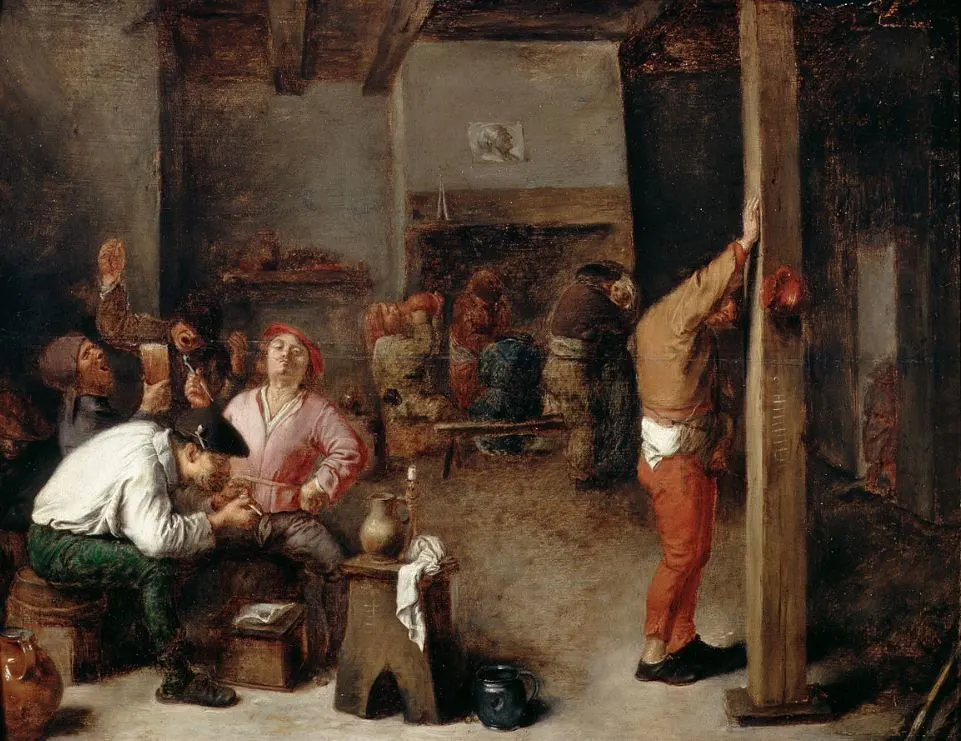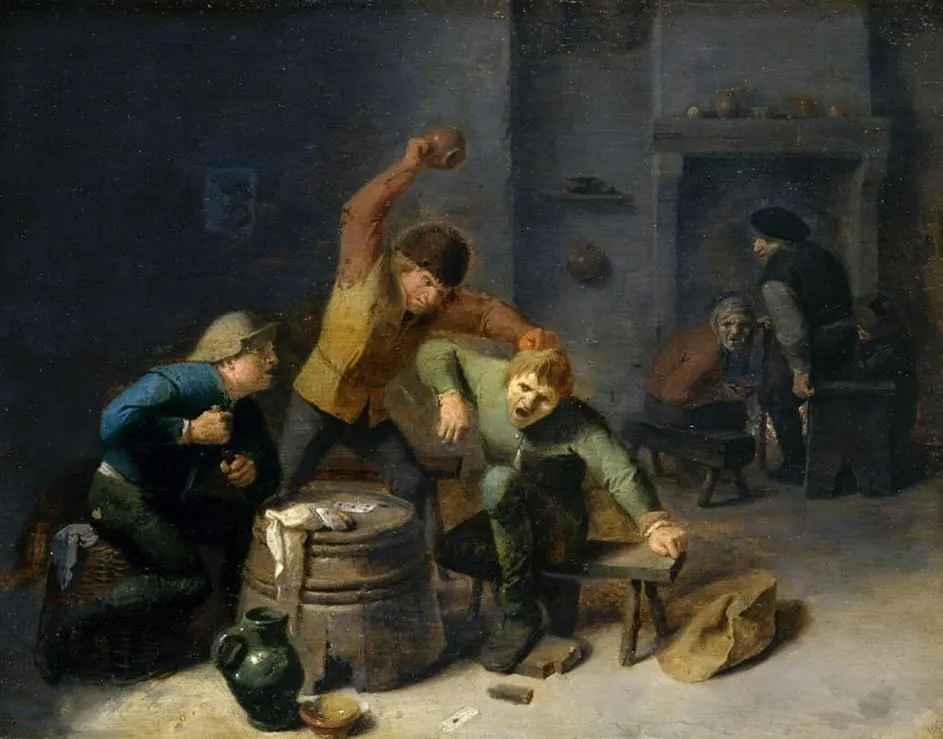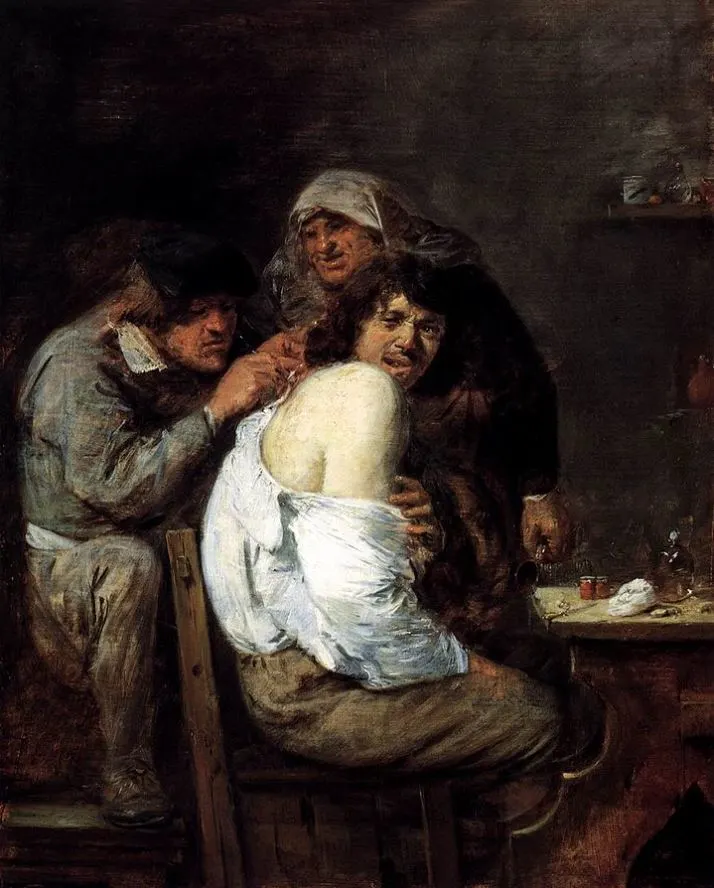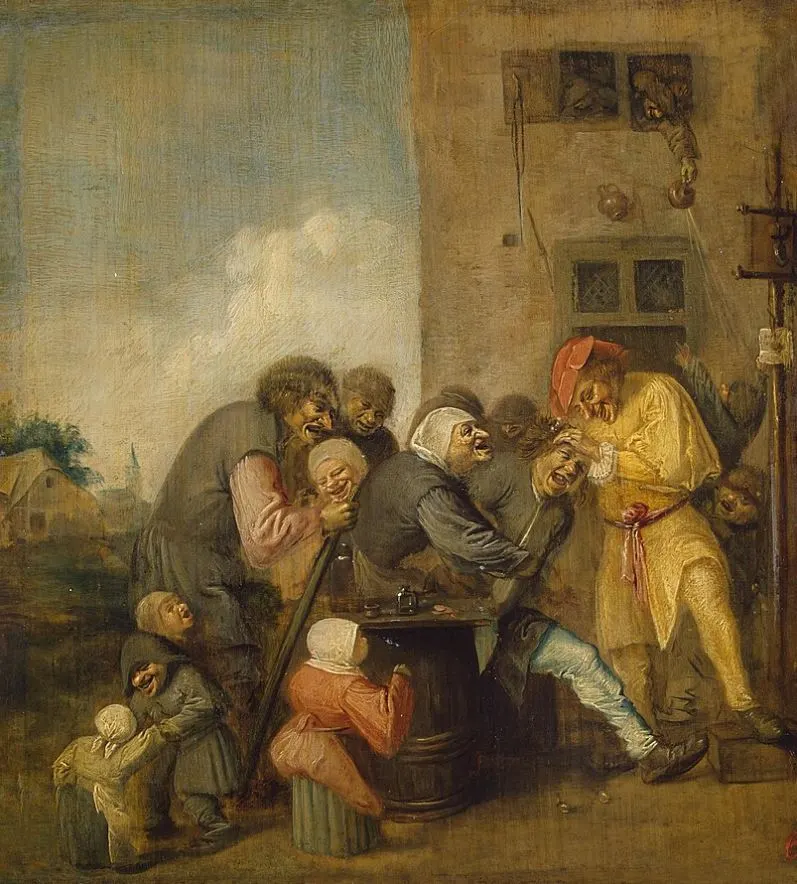Very few Flemish artists were so influential to Dutch Golden Age painters as this enigmatic character in art history.
Adriaen Brouwer (1605-1638) was most likely born in Oudenaarde, a relatively small city in the East Flanders province of modern-day Belgium.
The city he was born in features his statue on one of the picturesque roads. If you look closely, you can discover it in the video on the Art-Facts channel below.
Even though Oudenaarde takes great pride in the fact that Brouwer was born here, he spent most of his working days in the Dutch Republic and Antwerp.
Among his admirers were none other than Frans Hals (1582-1666), who was reportedly his master at one point, and Peter Paul Rubens (1577-1640).
These were two of the most talented artists of the Baroque era and both collected paintings produced by Adriaen Brouwer.
Let’s take a closer look at some of Brouwer’s most notable works so you can learn all about this talented painter.
1. The Smokers
- Date created: 1636
- Dimensions: 46.4 × 36.8 centimeters (18.25 × 14.5 inches)
- Location: MET Museum, New York City, United States
The Smokers isn’t just one of the iconic Adriaen paintings, it’s also one that gives us a glimpse of the lifestyle of the painter. Here we can see the artist himself, the man exhaling smoke while facing the viewer with an open mouth.
The other dubious figures haven’t been identified with certainty, but it’s very likely that they were his colleague artists. As you’ll soon discover, hanging out in taverns, drinking, and smoking, was one of Brouwer’s favorite pastimes.

2. The Bitter Draught
- Date created: 1635
- Dimensions: 47.4 x 35.5 centimeters (18.6 x 13.9 inches)
- Location: Städel Museum, Frankfurt, Germany

The Bitter Draught is one of the paintings by Brouwer that highlights his interest in facial expressions. This aspect of his oeuvre not only attracted influential patrons such as Rubens and Hals but also influenced many other Dutch Golden Age painters.
This particular work depicts a young man who clearly just drank a bitter type of liquid, most likely medicine. It was painted during the final years of the artist’s life, shortly before he died from the plague.

3. Youth Making a Face
- Date created: 1632-1635
- Dimensions: 13.7 x 10.5 centimeters (5.3 x 4.1 inches)
- Location: National Gallery of Art, Washington D.C., United States
Youth Making a Face is another prime example of the “Tronie” genre which Brouwer heavily influenced in the Dutch Republic in the 17th century. It consists of nothing more than a young man making a funny face.
Adriaen Brouwer loved depicting the common man, including peasants and lower-class individuals. Art historians still doubt whether or not he painted these people just for the fun of it or as he intended his paintings to serve as a critique of these people’s behavior.

4. Interior of a Tavern
- Date created: 1630
- Dimensions: 32.4 x 43.2 centimeters (12.7 x 17 inches)
- Location: Dulwich Picture Gallery, London, United Kingdom
Interior of a Tavern is the title of a painting that depicts the place where Brouwer spent most of his adult life, the local tavern. Here, he got copious amounts of inspiration to work with as it was full of drunkards and prostitutes.
As you can see, there are a whole lot of things going on, including people smoking, drinking, and apparently, trying to get it on with the ladies. Yes, these were definitely lower-class people of the 17th century enjoying themselves.

5. Peasants Brawling Over Cards
- Date created: 1631-1633
- Dimensions: 26.5 x 34.5 centimeters (10.4 x 13.5 inches)
- Location: Gemäldegalerie Alte Meister, Dresden, Germany
Peasants Brawling Over Cards is the title of a painting that depicts yet another recurring subject in the artist’s oeuvre, drunkards who start a fight. I think it’s clear that he often saw this happening while he was indulging in alcohol and tobacco himself.
Apart from the subject matter, this painting shows the artist’s skillful use of light sources, an element that many Dutch Golden Age painters perfected.
The light source coming from the bottom right highlights the fighting peasants in the ground while a less strong light source does the same for the people sitting at the back.

6. The Back Operation
- Date created: 1635-1636
- Dimensions: 34 x 27 centimeters (13.3 x 10.6 inches)
- Location: Städel Museum, Frankfurt, Germany
The Back Operation is a fascinating work of art that depicts how people were treated back in the 17th century when they had medical problems. As you can see, the conditions were still pretty primitive and void of any modern safety measures at all.
Apart from depicting joy, anger, fear, or other funny faces, he focused on depicting pain in this small work of art. It’s fair to conclude that Brouwer managed to paint just about any type of emotion human beings can experience, and he did so masterfully.

7. A Boor Asleep
- Date created: 1630-1638
- Dimensions: 36.6 x 27.6 centimeters (14.4 x 10.8 inches)
- Location: Wallace Collection, London, United Kingdom
A Boor Asleep is the title of a work that places a sleeping man in the foreground while others are seen in the dark behind the wooden separation. As usual, all these individuals belonged to the lower classes of society.
It’s unclear when he painted this work, but it’s likely that it was completed during the 1630s, just like almost every other work in this list of Adriaen Brouwer’s most famous paintings. It ended up in London after it was acquired by Francis Charles Seymour-Conway, 3rd Marquess of Hertford (1777-1842) in Paris in 1804.

8. Tavern Scene
- Date created: 1635
- Dimensions: 48 x 67 centimeters (18.8 x 26.3 inches)
- Location: National Gallery, London, United Kingdom
Tavern Scene is yet another painting that depicts a scene in one of the gloomy taverns that could be found all around the Low Countries in the 17th century. The rowdy crowd is clearly in fine form as they watch the young man and woman on the left.
It’s clear that the man is trying to accomplish something while the woman fights to stop him. The struggle even attracts the attention of people outside of the room. We can see a man peak through the opening, just above the hopeless romantic and the poor young lady.

9. Village Charlatan (The Operation for Stone in the Head)
- Date created: 1620s
- Dimensions: 28,2 x 25 centimeters (11.2 × 9.8 inches)
- Location: Hermitage Museum, Saint Petersburg, Russia
Village Charlatan (The Operation for Stone in the Head) is the title of the only painting in this list that was completed during the 1620s. While this early work features all the characteristics of his later body of work, it was clearly inspired by other, similar works on the same subject.
What appears to be another operation is actually a fictive depiction of what was referred to back then as “extracting the stone of stupidity.” This subject was painted by 16th-century artists such as Hieronymus Bosch and Pieter Bruegel the Elder and these works probably inspired Brouwer.
Interestingly, the two shiny stones lying at the feet of the charlatan and quack doctor represent the so-called “Stone of stupidity.”

10. Dune Landscape by Moonlight
- Date created: 1635-1637
- Dimensions: 25 x 34 centimeters (9.8 x 13.3 inches)
- Location: Gemäldegalerie, Berlin, Germany
Dune Landscape by Moonlight is another late work by Brouwer and one of the few landscapes that he completed. It shows that he was a versatile artist who might have produced a lot more similar works had he been given more time.
The few landscapes he painted were done in the same style featuring loose brushwork and were also highly influential to other landscape painters of the time.

